Stephen L. Smith
University of Waterloo
Bench-NPIN: Benchmarking Non-prehensile Interactive Navigation
May 17, 2025Abstract:Mobile robots are increasingly deployed in unstructured environments where obstacles and objects are movable. Navigation in such environments is known as interactive navigation, where task completion requires not only avoiding obstacles but also strategic interactions with movable objects. Non-prehensile interactive navigation focuses on non-grasping interaction strategies, such as pushing, rather than relying on prehensile manipulation. Despite a growing body of research in this field, most solutions are evaluated using case-specific setups, limiting reproducibility and cross-comparison. In this paper, we present Bench-NPIN, the first comprehensive benchmark for non-prehensile interactive navigation. Bench-NPIN includes multiple components: 1) a comprehensive range of simulated environments for non-prehensile interactive navigation tasks, including navigating a maze with movable obstacles, autonomous ship navigation in icy waters, box delivery, and area clearing, each with varying levels of complexity; 2) a set of evaluation metrics that capture unique aspects of interactive navigation, such as efficiency, interaction effort, and partial task completion; and 3) demonstrations using Bench-NPIN to evaluate example implementations of established baselines across environments. Bench-NPIN is an open-source Python library with a modular design. The code, documentation, and trained models can be found at https://github.com/IvanIZ/BenchNPIN.
AUTO-IceNav: A Local Navigation Strategy for Autonomous Surface Ships in Broken Ice Fields
Nov 26, 2024



Abstract:Ice conditions often require ships to reduce speed and deviate from their main course to avoid damage to the ship. In addition, broken ice fields are becoming the dominant ice conditions encountered in the Arctic, where the effects of collisions with ice are highly dependent on where contact occurs and on the particular features of the ice floes. In this paper, we present AUTO-IceNav, a framework for the autonomous navigation of ships operating in ice floe fields. Trajectories are computed in a receding-horizon manner, where we frequently replan given updated ice field data. During a planning step, we assume a nominal speed that is safe with respect to the current ice conditions, and compute a reference path. We formulate a novel cost function that minimizes the kinetic energy loss of the ship from ship-ice collisions and incorporate this cost as part of our lattice-based path planner. The solution computed by the lattice planning stage is then used as an initial guess in our proposed optimization-based improvement step, producing a locally optimal path. Extensive experiments were conducted both in simulation and in a physical testbed to validate our approach.
Autonomous Navigation in Ice-Covered Waters with Learned Predictions on Ship-Ice Interactions
Sep 18, 2024Abstract:Autonomous navigation in ice-covered waters poses significant challenges due to the frequent lack of viable collision-free trajectories. When complete obstacle avoidance is infeasible, it becomes imperative for the navigation strategy to minimize collisions. Additionally, the dynamic nature of ice, which moves in response to ship maneuvers, complicates the path planning process. To address these challenges, we propose a novel deep learning model to estimate the coarse dynamics of ice movements triggered by ship actions through occupancy estimation. To ensure real-time applicability, we propose a novel approach that caches intermediate prediction results and seamlessly integrates the predictive model into a graph search planner. We evaluate the proposed planner both in simulation and in a physical testbed against existing approaches and show that our planner significantly reduces collisions with ice when compared to the state-of-the-art. Codes and demos of this work are available at https://github.com/IvanIZ/predictive-asv-planner.
Approximate Environment Decompositions for Robot Coverage Planning using Submodular Set Cover
Sep 04, 2024



Abstract:In this paper, we investigate the problem of decomposing 2D environments for robot coverage planning. Coverage path planning (CPP) involves computing a cost-minimizing path for a robot equipped with a coverage or sensing tool so that the tool visits all points in the environment. CPP is an NP-Hard problem, so existing approaches simplify the problem by decomposing the environment into the minimum number of sectors. Sectors are sub-regions of the environment that can each be covered using a lawnmower path (i.e., along parallel straight-line paths) oriented at an angle. However, traditional methods either limit the coverage orientations to be axis-parallel (horizontal/vertical) or provide no guarantees on the number of sectors in the decomposition. We introduce an approach to decompose the environment into possibly overlapping rectangular sectors. We provide an approximation guarantee on the number of sectors computed using our approach for a given environment. We do this by leveraging the submodular property of the sector coverage function, which enables us to formulate the decomposition problem as a submodular set cover (SSC) problem with well-known approximation guarantees for the greedy algorithm. Our approach improves upon existing coverage planning methods, as demonstrated through an evaluation using maps of complex real-world environments.
Estimating Visibility from Alternate Perspectives for Motion Planning with Occlusions
Apr 11, 2024



Abstract:Visibility is a crucial aspect of planning and control of autonomous vehicles (AV), particularly when navigating environments with occlusions. However, when an AV follows a trajectory with multiple occlusions, existing methods evaluate each occlusion individually, calculate a visibility cost for each, and rely on the planner to minimize the overall cost. This can result in conflicting priorities for the planner, as individual occlusion costs may appear to be in opposition. We solve this problem by creating an alternate perspective cost map that allows for an aggregate view of the occlusions in the environment. The value of each cell on the cost map is a measure of the amount of visual information that the vehicle can gain about the environment by visiting that location. Our proposed method identifies observation locations and occlusion targets drawn from both map data and sensor data. We show how to estimate an alternate perspective for each observation location and then combine all estimates into a single alternate perspective cost map for motion planning.
To Lead or to Follow? Adaptive Robot Task Planning in Human-Robot Collaboration
Jan 03, 2024



Abstract:Adaptive task planning is fundamental to ensuring effective and seamless human-robot collaboration. This paper introduces a robot task planning framework that takes into account both human leading/following preferences and performance, specifically focusing on task allocation and scheduling in collaborative settings. We present a proactive task allocation approach with three primary objectives: enhancing team performance, incorporating human preferences, and upholding a positive human perception of the robot and the collaborative experience. Through a user study, involving an autonomous mobile manipulator robot working alongside participants in a collaborative scenario, we confirm that the task planning framework successfully attains all three intended goals, thereby contributing to the advancement of adaptive task planning in human-robot collaboration. This paper mainly focuses on the first two objectives, and we discuss the third objective, participants' perception of the robot, tasks, and collaboration in a companion paper.
Human Leading or Following Preferences: Effects on Human Perception of the Robot and the Human-Robot Collaboration
Jan 02, 2024Abstract:Achieving effective and seamless human-robot collaboration requires two key outcomes: enhanced team performance and fostering a positive human perception of both the robot and the collaboration. This paper investigates the capability of the proposed task planning framework to realize these objectives by integrating human leading/following preference and performance into its task allocation and scheduling processes. We designed a collaborative scenario wherein the robot autonomously collaborates with participants. The outcomes of the user study indicate that the proactive task planning framework successfully attains the aforementioned goals. We also explore the impact of participants' leadership and followership styles on their collaboration. The results reveal intriguing relationships between these factors, which warrant further investigation in future studies.
Scalarizing Multi-Objective Robot Planning Problems using Weighted Maximization
Dec 12, 2023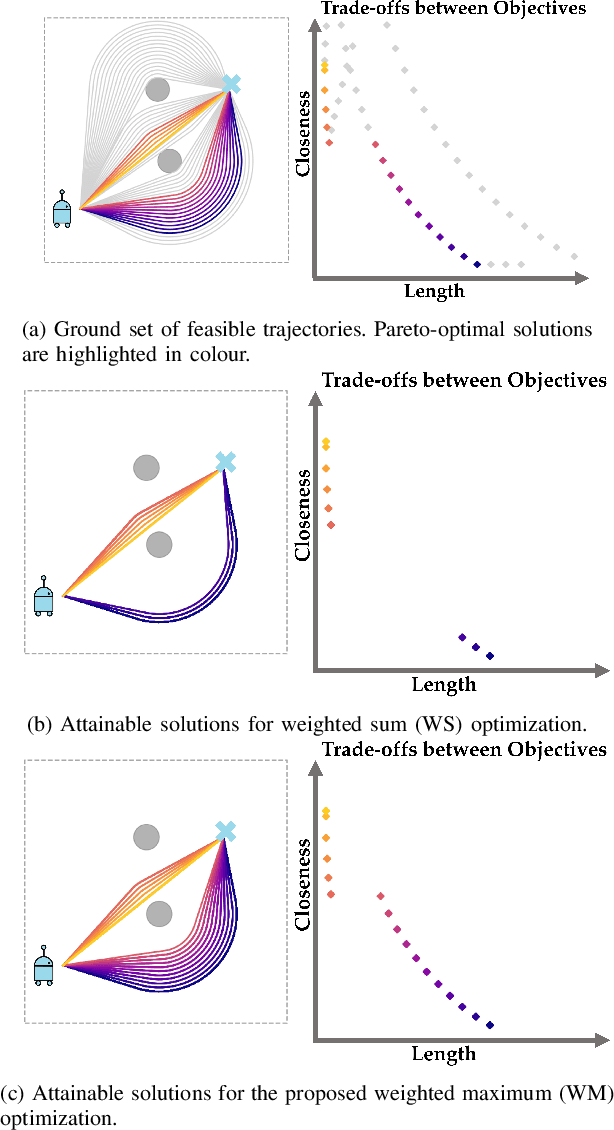
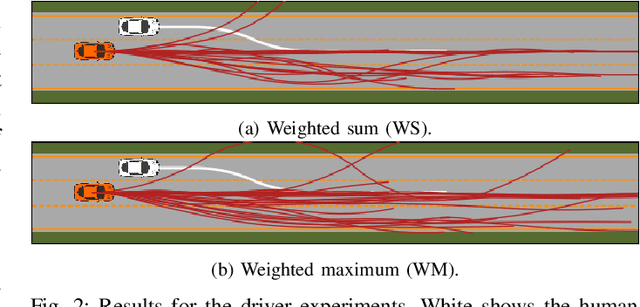
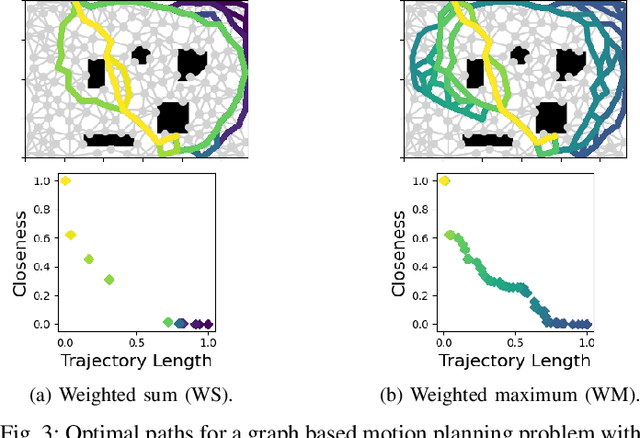
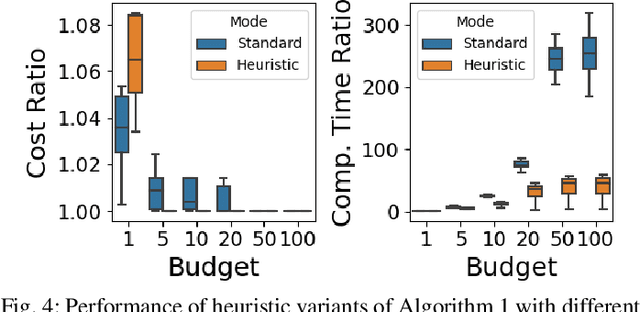
Abstract:When designing a motion planner for autonomous robots there are usually multiple objectives to be considered. However, a cost function that yields the desired trade-off between objectives is not easily obtainable. A common technique across many applications is to use a weighted sum of relevant objective functions and then carefully adapt the weights. However, this approach may not find all relevant trade-offs even in simple planning problems. Thus, we study an alternative method based on a weighted maximum of objectives. Such a cost function is more expressive than the weighted sum, and we show how it can be deployed in both continuous- and discrete-space motion planning problems. We propose a novel path planning algorithm for the proposed cost function and establish its correctness, and present heuristic adaptations that yield a practical runtime. In extensive simulation experiments, we demonstrate that the proposed cost function and algorithm are able to find a wider range of trade-offs between objectives (i.e., Pareto-optimal solutions) for various planning problems, showcasing its advantages in practice.
Minimizing Robot Digging Times to Retrieve Bins in Robotic-Based Compact Storage and Retrieval Systems
Dec 08, 2023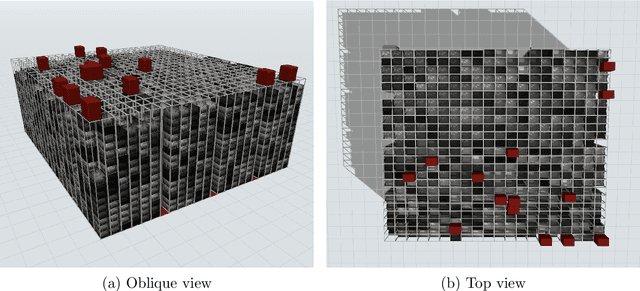

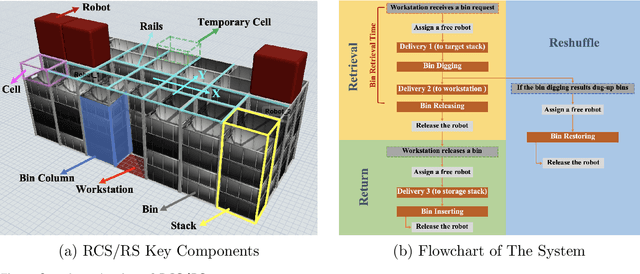

Abstract:Robotic-based compact storage and retrieval systems provide high-density storage in distribution center and warehouse applications. In the system, items are stored in bins, and the bins are organized inside a three-dimensional grid. Robots move on top of the grid to retrieve and deliver bins. To retrieve a bin, a robot removes all bins above one by one with its gripper, called bin digging. The closer the target bin is to the top of the grid, the less digging is required to retrieve the bin. In this paper, we propose a policy to optimally arrange the bins in the grid while processing bin requests so that the most frequently accessed bins remain near the top of the grid. This improves the performance of the system and makes it responsive to changes in bin demand. Our solution approach identifies the optimal bin arrangement in the storage facility, initiates a transition to this optimal set-up, and subsequently ensures the ongoing maintenance of this arrangement for optimal performance. We perform extensive simulations on a custom-built discrete event model of the system. Our simulation results show that under the proposed policy more than half of the bins requested are located on top of the grid, reducing bin digging compared to existing policies. Compared to existing approaches, the proposed policy reduces the retrieval time of the requested bins by over 30% and the number of bin requests that exceed certain time thresholds by nearly 50%.
Anytime Replanning of Robot Coverage Paths for Partially Unknown Environments
Nov 29, 2023
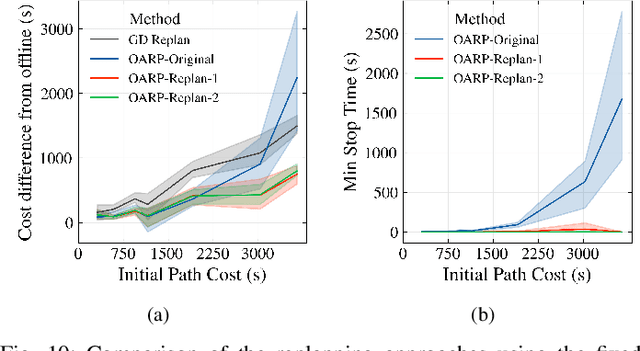

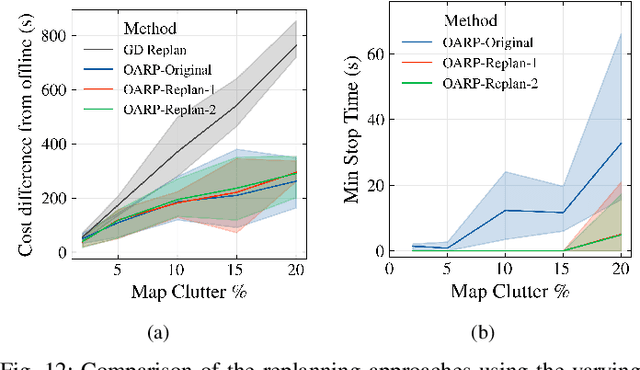
Abstract:In this paper, we propose a method to replan coverage paths for a robot operating in an environment with initially unknown static obstacles. Existing coverage approaches reduce coverage time by covering along the minimum number of coverage lines (straight-line paths). However, recomputing such paths online can be computationally expensive resulting in robot stoppages that increase coverage time. A naive alternative is greedy detour replanning, i.e., replanning with minimum deviation from the initial path, which is efficient to compute but may result in unnecessary detours. In this work, we propose an anytime coverage replanning approach named OARP-Replan that performs near-optimal replans to an interrupted coverage path within a given time budget. We do this by solving linear relaxations of mixed-integer linear programs (MILPs) to identify sections of the interrupted path that can be optimally replanned within the time budget. We validate our approach in simulation using maps of real-world environments and compare our approach against a greedy detour replanner and other state-of-the-art approaches.
 Add to Chrome
Add to Chrome Add to Firefox
Add to Firefox Add to Edge
Add to Edge